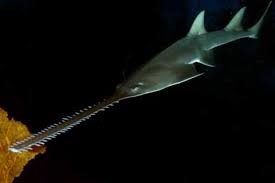Overview
Rays are fish that are close relatives of sharks. There are over 600 species, and most live in tropical or subtropical marine environments. Like sharks, their skeletons are made of cartilage rather than bone. They live on the sea floor, and some species eat smaller fish, other bottom-dwellers such as crustaceans, and others eat plankton. There are four main types of rays, commonly known as stingrays, skates, electric rays, and shovelnose rays.
Stingrays
Many stingray species live in coastal tropical and subtropical waters around the world, and a few live in freshwater rivers. They live nearest the sea floor or nearest to the riverbed. They have flattened bodies, and their eyes are on top of their bodies, while their mouths are on the underside. They hide in the sand, and sense their prey by smell and by sensitive organs that detect the electrical currents given off by living creatures. Most species feed on creatures that live on the sea floor, such as mollusks, crustaceans, and some small fish. The venomous stingers in their tails are used for self-defense, and they are provoked if an unwary swimmer steps on them. TV personality Steve Irwin died in 2006 while filming a documentary, when the barb from a stingray’s tail pierced his heart, causing massive and fatal injuries.
Skates
Skates have flat bodies and enlarged pectoral fins that undulate through the water. Their eyes are at the top of their head and their gills on the underside of their bodies. They live near the sea beds throughout all the oceans, including some species that are found in the Arctic and Antarctic. They feed on creatures that live on or near the sea floor, or on plankton. Some live in rivers or in estuaries. Like the stingrays, most give birth to live young, although some lay eggs inside a protective capsule called a “mermaid’s purse.”
Electric Rays
Electric rays are a small group of rays with flattened bodies and enlarged pectoral fins that produce an electric discharge to stun prey or in self-defense. The electric voltage is anywhere from 8 to 220 volts, depending on the size of the fish. Some of them are also known as “crampfish” or “numbfish”, of the genus Torpedo. Their unusual properties were used by the ancient Greeks and Romans as anesthesia and to cure headaches, as their currents are strong enough to stun humans.
Shovelnose Rays
Shovelnose rays and sawfishes are similar to sharks, with smaller pectoral fins than other types of rays. They have long, flat snouts with rows of teeth on either side that look like saws, and they use their snouts to dig in the mud for prey, slashing them and impaling them. Some species are 20 feet long, and can enter rivers or lakes. Like other forms of rays, all sawfish are either endangered species or critically endangered species. Most have been overfished, and many types of stingrays are used for food.
Interested in science tutoring services? Learn more about how we are assisting thousands of students each academic year.
SchoolTutoring Academy is the premier educational services company for K-12 and college students. We offer tutoring programs for students in K-12, AP classes, and college. To learn more about how we help parents and students in St. John, NB, Canada visit: Tutoring in St John,NB, Canada



